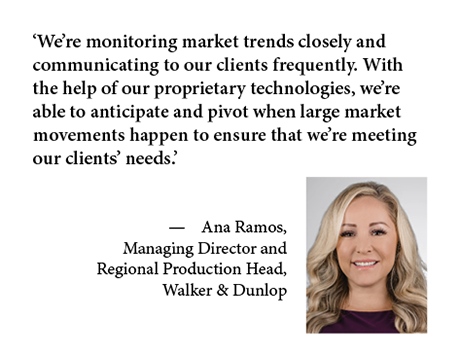Capitalizing on a changing marketplace and employing technology to streamline processes are essential strategies in helping small balance clients meet their goals. Ana Ramos, managing director and regional production head at Walker & Dunlop, emphasizes the importance of speed, creativity and using technology to assist in mortgage lending processes.
She also emphasizes the centrality of teamwork, company ethos and technology to put a big emphasis on small balance loans. Walker & Dunlop defines “small loan” as up to $15 million for multifamily properties with five or more units. These clients are usually composed of smaller individual investors who need attention and education when it comes to mortgage lending.
“It’s really hard for a large producer to think small, but it’s really easy for small producer to think big,” Ramos says. “It’s difficult for producers who are accustomed to institutional lending, with its higher fees and complex vesting structures to consider the credit parameters that are necessary in small balance loans. Small loans is a niche type of mortgage lending, and it only works if you have a company within a company, like Walker & Dunlop with its dedicated small loan team that works together through application, underwriting and closing.”
Tech’s Place in Small Balance Lending
Ramos cites Walker & Dunlop’s recent acquisition of data science company GeoPhy as an example of the company’s investment in making small loans successful. The web-based multifamily valuation tool shortens timelines and provides a wealth of real-time information to appraisers and valuators.
“One of the big things that led me to Walker & Dunlop is that the company is technologically advanced. It is vital that we have technology as part of the small loans process, because you need to do a lot of small loans in order to establish a presence. Technology is also vital to scale and improving the lending process,” Ramos explains.
“If we don’t incorporate technology, we’ll never be able to achieve the volume that I know we want — $5 billion by 2025,” says Ramos. “The only way is with technology. That’s what Walker & Dunlop is doing by investing in digital tools and the right people. I’m hoping that we can make small loan lending as smooth and as efficient as single-family lending. I’m anticipating that the technology will make for even better customer service and will simplify the business of lending.”
Shared Values and Visions
Ramos explains that the keys to success within the small multifamily lending space are “adding value in personalizing, building a relationship with the client and knowing what the clients need and how to deliver — that’s success.”
Teamwork is paramount to Ramos in getting clients what they need. Ramos insists on a culture of mentorship for her employees. She also prizes team members who are, above all, available — and that need for availability often requires geographic proximity. “Having a physical presence where our clients are investing helps build trust in our team and certainty of execution,” says Ramos.
Walker & Dunlop’s culture helps Ramos advance her approach to customer focus. “The culture and training are factors that allow us to achieve success. We’re empowered, not only to make decisions, but to become a part of a network that’s both creating small loans and creating a voice, an ethos, a brand that ensures success.”
Small Multifamily Loan Clients Hungry for Information, Speed and Efficiency
Access to information within this market is another factor that calls for additional time and attention. Information on lending products can often be hard to find, therefore owners and operators of smaller properties find value in resources like Walker & Dunlop’s quote app, extensive access to data and the ability to provide reports on any market.
One factor that sets Walker & Dunlop apart from the traditional bank is their ability to lend through Fannie Mae and Freddie Mac, the government-sponsored enterprises (GSEs).
Ramos elucidates, “During recessions, COVID or any crisis historically, the GSEs never stop lending. While CMBS providers and banks have had to pull back during these times, the agencies are able to provide counter-cyclical capital.”
“For small multifamily sponsors, having a variety of capital programs, including products like our proprietary lending platform can make or break a deal,” says Ramos. “If something causes the agencies to pull back, by increasing rates and making an adjustment that doesn’t necessarily fit the client, it’s great to be able to offer alternative lending products.”
Volume in 2022
“Higher interest rates have definitely slowed down some of the pipeline. But we’re still busy,” says Ramos. “There is still a lot of capital out there and not enough supply for investors who are hungry for multifamily assets. What I think will be critical moving forward is getting creative in structuring deals as well as how we underwrite and assess loan amounts based on risk.”
Of rates, Ramos says, “Investors will acclimate to these rates; they just need a little bit of time. But according to the Fed and based on current events, we don’t anticipate rates going down. If anything, they may continue to rise.”
“One tactics we’ve used to reduce interest rate risk is by offering early rate locks and structuring deals to yield higher loan amounts,” Ramos explains.
Regarding overall volume in 2022, Ramos says, “We don’t expect volume to slow down, because there’s still a lot of capital and a lot of demand, especially for multifamily properties. We’re monitoring market trends closely and communicating to our clients frequently. With the help of our proprietary technologies, we’re able to anticipate and pivot when large market movements happen, to ensure that we’re meeting our clients’ needs.”
— By Sarah Daniels. Walker & Dunlop is a content partner of REBusinessOnline. For more articles from and news about Walker & Dunlop, click here.


